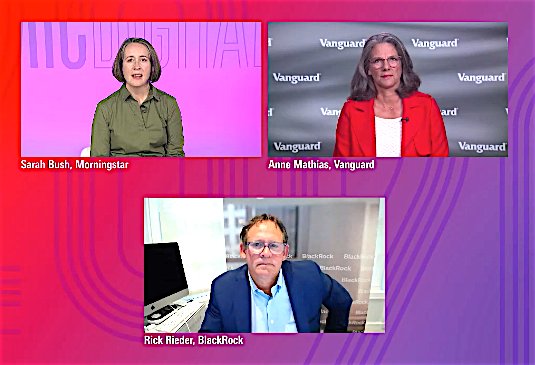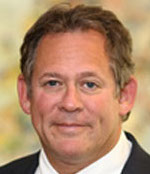
These are swell times for levering up, but sad times for lending. If you’re buying a house, you’re in luck. If you’re a retiree searching for safe yield, or an insurance company trying to fund long-term liabilities, luck is hard to find.
Few strategists know the bond market as well as Anne Mathias, senior strategist, fixed income, at Vanguard, and Rick Rieder, chief investment officer of global fixed income at BlackRock. Both participated in a discussion of interest rates, inflation, and other macro trends at the Morningstar Investment Conference last week.
In a webcast, “The Search for Yield in an Ultra-Low Interest Rate World,” they spoke with Morningstar’s Sarah Bush. [This was the first virtual version of the annual Morningstar conference. It was viewable by computer screen and through an Oculus VR headset and GatheringVR technology from Mesmerise, a UK firm.]
My takeaways:
- An actively managed “barbell” strategy may work best for bonds, with cash at one end and risky stuff at the other
- In the U.S., inflation is more a goal than a threat
- A weak service sector and hot tech stocks explain the perceived disconnect between a slow economy and strong financial markets
- Monetary policy is limited; fiscal stimulus and higher employment levels are essential for economic recovery
‘Security selection matters’
Today’s rate environment, Rieder said, calls for a “very different bond strategy from a year ago,” when the 10-year Treasury rate was 1.7% and the average yield on 10-year high quality corporate bonds was almost 2.9%. Even then, he noted, the “whole world was dialing for yield.” Today, that’s even more the case.

Rick Rieder
He recommends a barbell-shaped bond allocation. “Cash is one part of the barbell,” he said. “I’d rather be in cash than wasting beta in places that are currently too rich [like high-grade bond indexes]. There are some opportunities overseas, such as China. The European central bank intends to keep the euro zone’s rates low, but parts of the high-yield market there are interesting.”
Securitized debt (a favorite of private-equity led life insurers) can offer opportunity for the sophisticated investor. “In the last three months, a lot of return has been coming from bespoke opportunities,” Rieder said. “There’s mezzanine funding for big real estate transactions.” Average junk bond yields can be misleading because of concentration at the extremes of creditworthiness, he noted.
“Owning some TIPS makes sense, and some gold is a good idea. If you think the dollar is going to be under pressure, then you have to be 30% in gold. I’m not there, personally.” Getting income from large, stable dividend-paying companies makes sense. “It’s all about doing the research,” he said. “You have to be very precise in choosing securities.”
Vanguard’s Mathias agreed. “What matters now is security selection,” she said. “It’s time to search for true alpha. We know that rates will stay low, and that the Fed won’t shut off the recovery. So it’s a matter of doing the work and looking carefully for opportunities.”
Opportunities exist in the lower investment grade bonds and in the “lower- to middle-quality high-yield sector,” she said. She recommended some TIPS as a hedge. With inflation still well below where the Fed would like it to go, TIPS are a low-cost insurance policy for inflation,” she said.
Emerging market bonds—if you can find an issuing country with good governance and robust trade activity—represent another opportunity. “Emerging markets should benefit from our rate policy, Mathias said. “With rates near zero here, and no chance of moving up, and with the dollar stable-to-weakening—that’s all positive for emerging markets. You want to go to less energy-sensitive countries, and to those who are oriented to trade. Don’t go bottom-fishing. You want countries with responsible governance.”
Will low rates cause inflation?
Neither analyst expected inflation to be a near-term threat from low rates; the Fed, on the contrary, is trying to push the inflation rate higher. Rising wages are one traditional contributor to inflation, and Rieder said that wages aren’t necessarily headed higher.
“I don’t think that growing the monetary base by a lot creates inflation. In some areas, like energy and apparel, prices have already come down. We’re seeing companies bringing their costs structures down. They want to do everything they used to do, but at a lower price point. That’s a big headwind for inflation.”

Anne Mathias
“Structural factors still exist that will push inflation down,” said Mathias. “With COVID-19, companies are finding that they can do more with less—fewer people and a smaller footprint. That’s deflationary in itself. We also face this demographic issue of aging. The labor force is smaller relative to the overall population. We may end up with a higher structural level of unemployment.”
The historical dynamic—where unemployment falls, workers ask for higher wages, prices go up, and the Fed raise rates to cool down inflation—may no longer apply the way it used to.
Why stocks seem immune to downturn
Many people have wondered why equity prices are so high when certain segments of the economy are still so depressed. Rieder explained that service businesses constitute a third of the U.S. economy, but only a small percentage of the stock market’s valuation. So, a depression in services shouldn’t necessarily affect the markets.
He thinks many U.S. jobs, both in services or manufacturing, may be gone forever. “Trends in artificial intelligence, cloud technology, and virtual shopping accelerated to hyper-speed because of the pandemic,” he said, echoing a widely held assessment. “Manufacturers are learning how to work with smaller workforces. It will be hard to bring some of those jobs back.”
While he believes the Fed will make more asset purchases, Rieder believes the overall economy needs another injection of fiscal spending. “The Fed’s tools are blunt at this point. [Fed chairman Jay] Powell said that ‘fiscal has to take the ball from here.’ Whoever is president next year, we’re going to get another stimulus. And the system can take on more debt,” he said.
Asked about the potential impact of larger and larger federal deficits, Rieder said, “My opinion on deficits has evolved,” he said. “I recently read The Deficit Myth [by Modern Monetary Theory economist Stephanie Kelton]. It’s phenomenally good. The system is structured for the Fed to be a lender. As long as the U.S. has the world’s reserve currency, and as long as the dollar doesn’t come under tremendous downward pressure, there’s room for the debt to grow.

A virtual reality view of inner space at the Morningstar Investment Conference.
“There’s a limit to the amount you can issue, but I think the system can withstand more debt than the 1980s-1990s academic literature would suggest. The Fed has to buy more Treasuries and reduce the amount of mortgages they’re buying. It has to monetize the debt. But the main thing is getting more people back to work,” Rieder added.
“The fiscal piece is important,” Mathias said. The support has to continue or we’ll see a fall-off. So far, we’ve mostly seen income replacement. The government has been dumping ‘helicopter money’ on the population. People have been spending. But activity in services has been very slow to move up at all.”
Rates will stay low for years
“We can’t underplay the importance of what the Fed did in changing policy,” said Mathias, who expects that even if the U.S. economy approaches full employment, even if inflation surpasses the Fed’s target, and even if low rates fosters an asset bubble, the Fed’s recent language indicates that a rate hike is nowhere in the forecast.
“In its new statement on longer-run goals, the Fed said its decisions would be informed by its assessment of ‘shortfalls’ of employment from its maximum level,” Mathias said. “The previous version had referred to ‘deviations’ from its maximum level. The Fed is basically taking the Phillips Curve Framework off the table in terms of an input to inflation estimates and monetary policy. The Fed will no longer view the momentum of employment gains as an inflation risk. If unemployment is very low in the future, the Fed will not take it as a signal of coming inflation (as they have in the past) and will not act preemptively.
“This policy creates an environment where it’s harder for the market to predict when the Fed will start raising rates,” she added. “Nominal interest rates are effectively capped. The five to 10-year yields are effectively capped. Even in an inflationary environment, rates will stay below where they would normally be. The Fed is saying that it won’t feel pressured to raise rates for a very, very, very long time.”
© 2020 RIJ Publishing LLC. All rights reserved.

